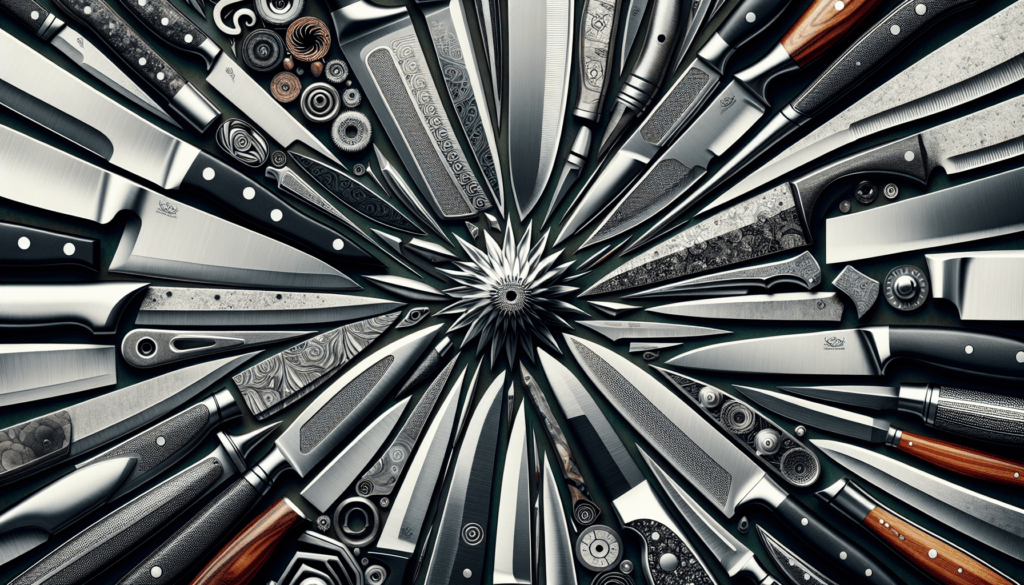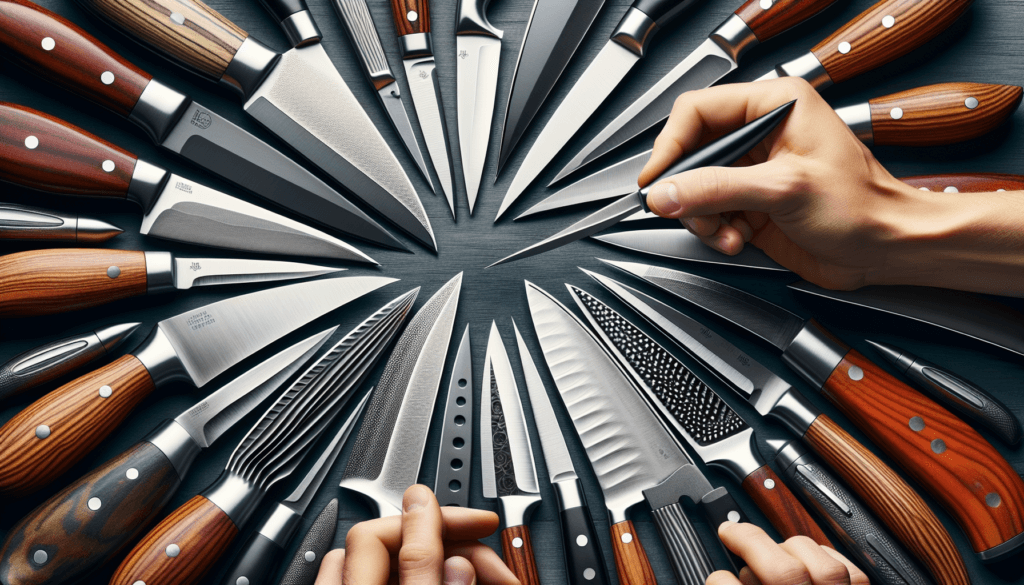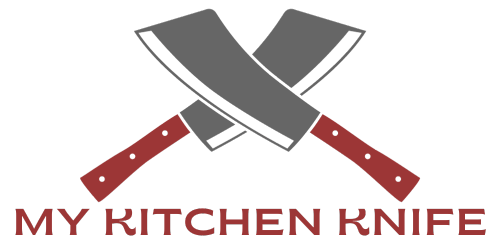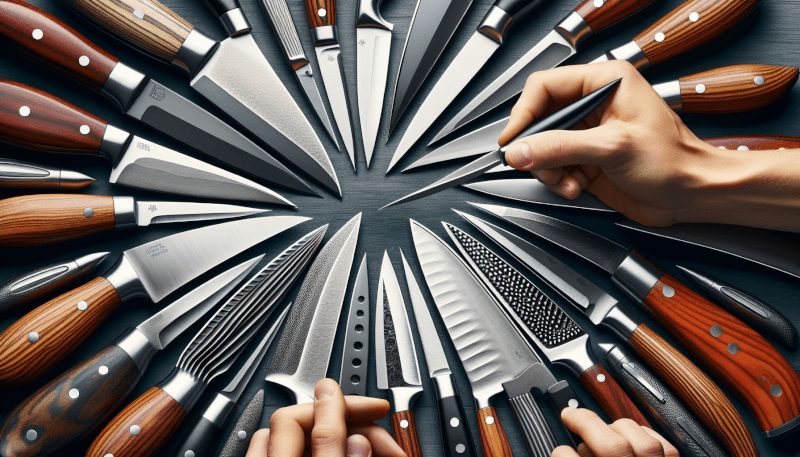Are you an aspiring chef or just someone who loves spending time in the kitchen? If so, then you know the importance of having the right kitchen knife. But with so many different types of kitchen knife blades available, it can be overwhelming to choose the right one for your needs. That’s why we’ve put together this comprehensive guide to help you navigate through the world of kitchen knife blades. From the versatile chef’s knife to the precision of a paring knife, we’ll break down the characteristics and uses of each blade type, so you can make an informed decision and elevate your cooking skills.
Fixed Blade Knives
Fixed blade knives are a popular choice for outdoor enthusiasts and professionals alike. They are known for their durability and strength, making them reliable tools for various tasks. There are different types of fixed blade knives, each with its own unique features and advantages.
Full Tang Knives
Full tang knives are among the strongest and most robust knives on the market. The term “full tang” refers to the blade extending all the way through the handle, providing exceptional stability and strength. This design ensures that the knife can withstand heavy-duty tasks without the risk of breaking or bending. Full tang knives are particularly favored by hunters, campers, and survivalists who require a sturdy and reliable tool for their outdoor adventures.
Partial Tang Knives
In contrast to full tang knives, partial tang knives only have a blade that extends partially into the handle. While they may not offer the same level of strength and durability as full tang knives, they can still be suitable for light to moderate tasks. Partial tang knives are often more affordable and lighter in weight, making them a popular choice for those who prioritize portability and versatility.
Rat-tail Tang Knives
Rat-tail tang knives have a unique construction where the blade tapers down into a narrow tang, resembling the shape of a rat’s tail. This type of tang is commonly found in low-cost or decorative knives. While rat-tail tang knives may be visually appealing, they are not designed for heavy or demanding use. They are best suited as decorative pieces or for light tasks in a kitchen setting.
Folding Knives
Folding knives, also known as pocket knives, are versatile and convenient tools that can be easily carried in your pocket or bag. They are popular among outdoor enthusiasts, adventurers, and everyday carry enthusiasts.
Traditional Pocket Knives
Traditional pocket knives, also referred to as slipjoint knives, are the classic folding knives that have been used for centuries. They are characterized by their simple and timeless design, with a non-locking folding mechanism. Traditional pocket knives usually have multiple blades, each serving a different purpose, such as a main blade, a pen blade, and a can opener. They are favored by those who appreciate the elegance and practicality of a traditional folding knife.
Lockback Knives
Lockback knives feature a locking mechanism that secures the blade in place when opened, providing added safety and stability during use. The lockback mechanism ensures that the blade remains open during tasks, preventing accidental closure that could potentially result in injury. These knives are trusted by hunters, hikers, and outdoor enthusiasts who require a reliable and secure folding knife for various applications.
Linerlock Knives
Linerlock knives utilize a locking mechanism where a metal liner inside the handle is pushed against the base of the blade, keeping it firmly in place when unfolded. This mechanism is activated by the user’s thumb or finger and provides a secure and easily operable lock. Linerlock knives are popular for their one-handed opening and closing abilities, making them highly convenient for tasks that require quick and easy knife access.

Utility Knives
Utility knives are an essential tool in every kitchen, designed specifically for food preparation. They come in various shapes and sizes, each serving a specific purpose to make culinary tasks easier and more efficient.
Chef’s Knife
The chef’s knife is perhaps the most versatile and important knife in any kitchen. With its broad, curved blade ranging from 6-10 inches in length, it is suitable for a wide range of tasks, including chopping, slicing, dicing, and mincing. The chef’s knife excels at handling larger ingredients, such as vegetables, meats, and herbs, providing the user with precise control and effortless cutting motions.
Paring Knife
The paring knife is a smaller knife with a narrow, pointed blade typically around 3-4 inches long. It is primarily used for intricate tasks that require precision, such as peeling fruits and vegetables, trimming, and detailed garnishing. The paring knife’s compact size allows for greater maneuverability and control, making it a go-to tool for delicate kitchen work.
Santoku Knife
Originating from Japan, the Santoku knife has gained popularity worldwide for its versatility and craftsmanship. It features a shorter, wider blade compared to a traditional chef’s knife, typically around 5-7 inches. The Santoku knife excels in slicing, dicing, and chopping, making it ideal for handling a variety of ingredients in the kitchen. Its flat edge allows for a precise downward cutting motion, while the Granton edge helps prevent food from sticking to the blade.
Specialized Knives
Specialized knives cater to specific culinary tasks that require specialized blades for optimal performance. These knives are designed to excel in their intended purpose, providing chefs and home cooks with the right tool for the job.
Bread Knife
The bread knife is readily recognized by its long, serrated blade, typically ranging from 8-10 inches in length. Its serrations enable it to effortlessly slice through crusty bread without crushing or tearing. The saw-like teeth of the bread knife grip the crust, allowing for clean and precise cuts. In addition to bread, it can also be used for slicing delicate pastries and cakes without crushing their soft interiors.
Slicing Knife
The slicing knife, also known as a carving knife, is particularly designed for slicing roasts, poultry, and other large cuts of meat. With its long, narrow blade ranging from 8-14 inches, it effortlessly glides through meat, creating thin, even slices. The smooth, non-serrated edge ensures minimal tearing and maintains the meat’s juices and flavor. A good slicing knife is an essential tool for anyone who loves to prepare and serve impressive roasts.
Boning Knife
The boning knife boasts a thin, narrow blade, typically around 5-7 inches, which is specifically designed for separating meat from bones. Its sharp, pointed tip allows for precise and controlled maneuvering around joints and bones. Whether you need to remove bones from fish, poultry, or meat, a boning knife is an invaluable tool for achieving clean and efficient cuts.

Steak Knives
Steak knives are a must-have for any avid steak lover or home entertainer. These knives are specifically designed to handle the tough and fibrous texture of steak, ensuring a smooth and enjoyable dining experience.
Serrated Edge Steak Knives
Serrated edge steak knives feature a serrated blade that effortlessly cuts through steak without tearing or shredding. The serrations grip the meat’s surface, allowing for easy slicing with minimal effort. These knives are often preferred for their ability to maintain a sharp edge for extended periods, ensuring consistent performance over time.
Straight Edge Steak Knives
Straight edge steak knives, also known as plain edge steak knives, have a smooth, non-serrated blade that creates clean and precise cuts. Unlike serrated knives, straight edge knives require a sharp edge to glide through steak effectively. These knives offer a pristine, polished look to the cut meat and are favored by those who prefer precise, controlled cuts.
Micro-serrated Edge Steak Knives
Micro-serrated edge steak knives combine the best of both worlds, offering the benefits of both serrated and straight edge blades. They feature tiny serrations along the blade, providing an added level of grip and cutting performance. Micro-serrated knives require less maintenance than traditional fully serrated blades, as they are easier to sharpen and keep sharp over time.
Ceramic Knives
Ceramic knives have gained popularity due to their unique properties and benefits. Made from zirconia, a high-density ceramic material, these knives offer exceptional sharpness and durability.
Advantages
Ceramic knives are highly regarded for their superior sharpness. The hardness of the ceramic material allows for a razor-sharp edge that stays sharper for longer compared to traditional steel knives. Additionally, ceramic blades are known for their resistance to staining and corrosion, ensuring that your knives will remain in pristine condition even after prolonged use. They are also lightweight, making them easy to maneuver and reducing fatigue during repetitive cutting tasks.
Disadvantages
One of the main drawbacks of ceramic knives is their fragility. Ceramic blades are prone to chipping or breaking if subjected to excessive force or dropped onto a hard surface. These knives are also not suitable for heavy-duty tasks, such as cutting through bones or frozen foods. Ceramic knives require special care and maintenance, as they should only be used on softer materials like fruits, vegetables, and boneless meats.
Care and Maintenance
To maintain the sharpness and longevity of ceramic knives, it is crucial to handle them with care. Avoid using them on hard surfaces or cutting through dense or frozen foods. Handwashing with mild soap and water is recommended, as dishwashers can cause unnecessary wear and tear. When storing, it is advisable to use a knife sheath or a designated knife block to protect the blade from chipping or contacting other objects.

Carbon Steel Knives
Carbon steel knives have been a favorite among professional chefs for centuries. Known for their exceptional edge retention and ease of sharpening, these knives offer a unique cutting experience.
Advantages
Carbon steel knives are revered for their superior sharpness and cutting performance. They can achieve an incredibly sharp edge that remains sharp for extended periods of use. In addition, carbon steel knives are relatively easy to sharpen, allowing you to maintain their performance over time. These knives are also known for their excellent heat conductivity, making them ideal for tasks that require precise temperature control, such as searing or browning.
Disadvantages
Carbon steel knives are prone to staining and corrosion if not properly cared for. They require diligent maintenance, including immediate rinsing and drying after use to prevent acidic substances from interacting with the metal. Carbon steel knives also tend to develop a patina over time, which some individuals appreciate for the unique character it brings but others may find unappealing. These knives are not recommended for cutting highly acidic foods, as the acid can cause the blade to react and impart an undesirable taste.
Care and Maintenance
Proper care and maintenance are essential to prolong the life of carbon steel knives. After each use, it is important to rinse and dry the blade immediately to prevent staining or corrosion. Additionally, applying a thin layer of oil to the blade can help to protect it between uses. Regular sharpening is necessary to maintain the knives’ sharpness, and using a honing steel or sharpening stone is recommended. When storing carbon steel knives, it is advisable to use a knife guard or a knife block to prevent them from coming into contact with other objects and causing unnecessary damage.
Stainless Steel Knives
Stainless steel knives are widely popular due to their versatility, affordability, and ease of maintenance. With a wide range of options available, stainless steel knives are suitable for various kitchen tasks and cooking styles.
Advantages
Stainless steel knives are valued for their resistance to staining, corrosion, and rust. They are highly durable and can withstand the wear and tear of everyday kitchen use. These knives are also relatively low maintenance, as they do not require immediate drying after use or regular oiling like carbon steel knives. Stainless steel blades offer a good balance of sharpness and ease of maintenance, making them a popular choice among both professional chefs and home cooks.
Disadvantages
While stainless steel knives offer many advantages, they can be more challenging to sharpen compared to carbon steel or ceramic knives. The softer nature of stainless steel requires more frequent sharpening to maintain optimal cutting performance. Additionally, some stainless steel knives may not hold their edge for as long as other materials, necessitating more frequent honing and sharpening.
Care and Maintenance
Stainless steel knives are relatively easy to care for. After each use, it is recommended to rinse the blade with warm water and mild detergent, followed by thorough drying to prevent any moisture buildup. While stainless steel knives are more resistant to staining, it is still advisable to avoid cutting highly acidic foods for prolonged periods. Regular honing with a honing steel can help maintain the knife’s sharpness, while periodic sharpening with a sharpening stone or a knife sharpener will be necessary to restore the edge when it becomes dull.

Damascus Steel Knives
Damascus steel knives are renowned for their exquisite craftsmanship and striking appearance. These knives have a long history and are highly regarded by collectors and knife enthusiasts alike.
History and Origins
The origins of Damascus steel date back centuries, with historical accounts tracing its production to the Middle East, specifically Syria. The technique for creating Damascus steel involves forging multiple layers of steel and iron together, resulting in a blade with a distinctive pattern known as “Damascus” or “Damascene.” This pattern is created through the repeated folding and layering process, which brings out the unique beauty and strength of the blade.
Distinctive Patterns
Damascus steel blades are recognized for their stunning patterns, characterized by wavy lines or swirls across the surface of the blade. These patterns are a result of the distinct process of forging and layering the steel. Each Damascus steel knife is unique, with no two blades having the exact same pattern. The visual appeal of the pattern, combined with the exceptional cutting performance, makes Damascus steel knives highly sought after by collectors and enthusiasts.
Care and Maintenance
To ensure the longevity of Damascus steel knives, proper care and maintenance are crucial. It is recommended to wash the blade by hand with mild soap and warm water, followed by thorough drying to prevent any moisture buildup. Storing the knife in a dry environment is essential to prevent rust or corrosion. Regular honing and sharpening will be necessary to maintain the knife’s sharpness, and using a honing steel or sharpening stone is recommended.
Laminated Steel Knives
Laminated steel knives are unique in their construction, combining multiple layers of steel to create a blade with exceptional strength and versatility.
Construction
Laminated steel knives typically consist of a core layer made from a high-carbon steel alloy, surrounded by layers of softer stainless steel. This construction technique allows the blade to have the edge retention and sharpness of the high-carbon steel, while the outer layers provide durability, stain resistance, and ease of maintenance. The layered design also adds visual appeal, with distinctive patterns visible on the blade.
Advantages
The laminated steel construction offers several advantages. The high-carbon steel core provides the knife with impressive cutting performance and edge retention. The stainless steel outer layers protect the core from staining and corrosion and make the knife easier to maintain. Laminated steel knives are known for their versatility, making them suitable for various kitchen tasks, including slicing, dicing, and chopping.
Disadvantages
While laminated steel knives offer many advantages, they can be more expensive compared to other types of knives due to their complex construction. Additionally, sharpening a laminated steel knife may require more skill and patience compared to sharpening a single-layer blade. The addition of multiple layers with different hardness can make it challenging to achieve consistent sharpening results.
In conclusion, choosing the right kitchen knife blade depends on personal preferences, intended use, and desired performance. Understanding the different types of knife blades, their advantages, disadvantages, and maintenance requirements can help you make an informed decision. Whether you opt for a full tang fixed blade knife for outdoor adventures, a versatile chef’s knife for your culinary endeavors, or a striking Damascus steel knife for its beauty and craftsmanship, the right knife can greatly enhance your cooking experience. Remember to handle your knives with care, maintain them regularly, and enjoy the art of cooking with precision and efficiency.



